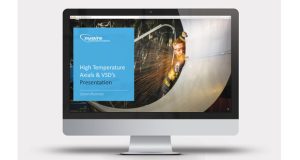In our special HVAC focus, heating and ventilation specialists explain the importance of local climate when specifying cooling systems, the significance of Lot 20, and what to do if your systems break down
In the search for energy and water efficiencies, cooling system specification can depend largely on regional weather conditions. Cooler climates like the UK are ideal for dry cooling or even free cooling to reduce energy consumption, but only if the relationship between local weather conditions and system performance is clearly understood.
Transtherm Cooling Industries is a designer and manufacturer of adiabatic technology. The company champions the use of climatic data in system design. Says Director Tim Bound: “During the specification stage, much emphasis is put on the anticipated efficiency and optimal performance outputs of a potential new cooler. This can be demonstrated in a number of ways, but the most efficient method of all is to analyse the specification against regional climatic weather data – something that many manufacturers of cooling technology just aren’t doing.”
 Even in the very early stages of specification, he says, decision-makers can narrow down which cooling technologies they should tender by arming themselves with some basic weather data for the UK. “For example, we know from a variety of sources, including the Met Office, that the average daily temperatures in the south west of England range from 5°C in January to 16.4°C in August, giving an average temperature across the year of around 10.3°C. Using this as a threshold, specifiers can make an informed choice for the selection of cooling technology that performs most efficiently in that region. It’s also important to remember that technology which leverages cooler UK temperatures can reduce reliance on water-hungry evaporative cooling.”
Even in the very early stages of specification, he says, decision-makers can narrow down which cooling technologies they should tender by arming themselves with some basic weather data for the UK. “For example, we know from a variety of sources, including the Met Office, that the average daily temperatures in the south west of England range from 5°C in January to 16.4°C in August, giving an average temperature across the year of around 10.3°C. Using this as a threshold, specifiers can make an informed choice for the selection of cooling technology that performs most efficiently in that region. It’s also important to remember that technology which leverages cooler UK temperatures can reduce reliance on water-hungry evaporative cooling.”
He points out that adiabatic technology can work efficiently in its more efficient, dry cooling mode for 97 per cent of the year when operating in colder climates like the UK, only switching to evaporative cooling when temperatures exceed 21-23°C. In mission-critical environments, that equates to a tiny three per cent of the year.
So how much can weather data tell us?
Using regional weather data from recent years, dedicated manufacturers can furnish their customers with complete breakdowns based on typical local dry bulb temperatures, and how many hours in a representative year the region experiences that temperature. Armed with this, new product quotations can be accompanied by an annual close-estimate summary, highlighting which mode the cooler will operate in throughout the year, how much energy and water it will consume, and how successful it will be in producing the required outlet water temperature as regional temperatures fluctuate.
Such an analysis can also give highly accurate indicative annual opex costs, offering complete transparency at the point of specification.
Free cooling, says Bound, can generate substantial cost and energy savings across a multitude of manufacturing and processing applications where water cooling is essential. Free cooling is a process which uses cold air from outside to cool water within a chilled water system. While it is not a direct replacement for chillers with refrigerated compressor units, it offers an alternative that saves energy and money for up to nine months of the year when the outside air is cool enough – preventing or reducing the need for energy-consuming chillers when the external conditions allow.
“Thanks to the extremely high energy efficiency of air blast coolers,” he comments, “operators can take advantage of low ambient air temperatures wherever possible throughout the year, totally or partially offloading the refrigerated chiller as appropriate.
“For businesses in the UK, where even spring and autumn can be particularly cool, payback on a system of this nature can be as short as four to six months, with substantial cost savings after that. Free cooling systems can also be retrofitted to most pre-existing water cooling equipment to prevent the need for a full cooling system overhaul – which means even more businesses can benefit from this trend as it continues to become best practice.”
PLANNING IS THE KEY
Shaun Hurworth of Glen Dimplex Heating and Ventilation notes the impact of Lot 20 of the EU’s Energy Efficiency Directive, launched in January, and why this requires good planning on the part of HVAC providers.
 “Like so much of facilities management best practice, the key is in the planning,” he says. “The growth of the internet of things and connected devices means there is no excuse for any organisation to go without a detailed plan of building services, including HVAC equipment. This enables forward planning and easy identification of any issues to allow for a swift response, and should always be the first step for any FM. However, it pays to work closely with your chosen equipment supplier too.”
“Like so much of facilities management best practice, the key is in the planning,” he says. “The growth of the internet of things and connected devices means there is no excuse for any organisation to go without a detailed plan of building services, including HVAC equipment. This enables forward planning and easy identification of any issues to allow for a swift response, and should always be the first step for any FM. However, it pays to work closely with your chosen equipment supplier too.”
Lot 20 signalled the biggest change in electric heating for more than 20 years. Aimed at improving the efficiency of heating products, the legislation states that all ‘fixed’ local heating appliances (those which generate heat in the location in which they are situated) must meet a minimum energy efficiency standard. In many cases, this can be achieved through the addition of intelligent controls.
“As a result, leading manufacturers have redesigned their products to incorporate a range of features such as open window detection and anticipatory control, with integral controls now required on all direct acting electric heaters,” says Hurworth. “Crucially, this has given us the opportunity to standardise the intelligent control system used across many Dimplex products.”
Driven by the requirements of Lot 20, facilities managers can take advantage of consistent controls for easier and quicker operation of their HVAC system, reducing running costs and improving comfort for the building occupants.
“But,” says Hurworth, “don’t forget that one of the best ways to maximise system performance is to design it correctly in the first place. So often HVAC systems are made to work harder than they need to because of incorrect specification, which can lead to reduced efficiencies and more frequent breakdowns.”




